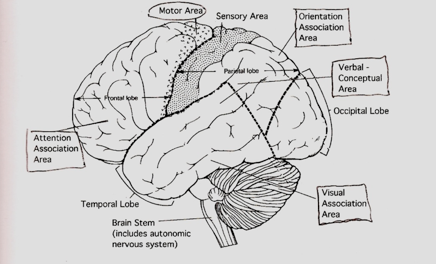Worship Movements 4/5: With Every Ounce...
“This is your brain on worship!” Remember those commercials that showed an egg frying and said, “This is your brain on drugs?” That commercial claims one of the most memorable lines of advertising, proven by the laughter of recognition I get whenever I use this intro in my workshops and show this picture. Actually, the picture doesn’t really represent your brain on worship, but the image is a reminder that our brains are made up of various sections that process information in different ways. The more sections of the brain we can get activated in worship, the more memorable the message will be.
I’ve been writing lately about how 20th century worship movements have influenced mainline expressions (liturgical, contemporary, pentecostal, etc). This week, I want to comment on the resurgence of the arts in worship. I believe we can call this a “movement” unto itself. Hailed for centuries as a “word alone” tradition, Protestantism has recently rediscovered what the scriptures meant by praising God “with every ounce of our being.”
I’m a neuroscience nerd. I studied research related to ritual and neuroscience for my dissertation, as well as theories coming out of kinesiology and other kinesthetic sciences. What we can learn from those who study memory and cognition has profound implications for our worship. The connection here to the worship and arts movement is that our brains are firing off with amazing complexity these days as “the Word” is being not only spoken, but danced, seen, felt and moved!
Introducing a wider diversity of arts into mainline worship hasn’t been easy (and still isn’t). I was a professional dancer in my first career, and my first “steps” into worship leadership were through dance. I quickly learned that I couldn’t just dance, I had to learn to talk about the ancient history of dance in worship and about why dancing is appropriate in worship. I also had to learn to give permission for folks to interpret a dance they experienced as moving symbolism. All kinds of attitudes and fears about bodies have made the road toward kinesthetic expression in worship not an easy fit immediately for Protestants.
Likewise, as we began to expand our use of visuals, both tangible and digital, we had to confront the centuries-old attitudes about images that the Protestant tradition had railed against early on. Still today, changing the objects on an altar table in our spaces beyond the typical two candles, a cross and a Bible, is a process that must be handled with care and education. Banners were a nice first step in the 20th century, but now we are moving beyond banners to creating visual environments that enhance the message. The biggest thing that comes up in my session on the “politics of change” is the process of adding digital media and screens to a worship space. Adding digital media is a very difficult move for many who cannot imagine how this form of communication will add to, rather than distract from, the Word.
As a ritual artist, I am all for utilizing every form of expression”””every ounce of our being”””to express the Gospel good news. However, some objections to art in worship have a point. As with the other blogs, I want to offer some points of discernment around appropriating this movement into our worship:
Ritual art is different from art in any other venue. The art we do in worship is expressly offered in order to communicate a message. Visual art shouldn’t just be “pretty” but must be offered with “integrity” (all the pieces are part of the whole). Just putting a bunch of stuff on a table doesn’t mean that the “stuff” is helping us enter the message in a deeper way. Artists must be theologians. We must be “symbolists” who discern how any one object, color scheme, metaphor and image is communicating the message well. But watch out for literalism. Always putting words on fabric still keeps the visual within the “verbal” realm. We have words for that. Let color and texture speak for itself.
Just because you can do a triple pirouette or stand on one leg doesn’t mean that these are the right steps to communicate your message. Dancing in church is not just about putting pretty steps together but rather expressing an aspect of the Story. Movement is symbol as well, and sometimes simple is the most profound. “Drama” doesn’t mean just skits; there are many ways to dramatize a moment and a message. Digital media becomes a wasted medium when we treat screens as “big ole bulletins.” When we use screens just to project words of songs and scripture, we aren’t utilizing this medium as an art form. Move out of the simply informational approach to create works of digital media art that enhance the message in ways mere words cannot. There are so many ways to make projections aesthetically beautiful and provocatively expressive.
Don’t rely only on such a small range of sound. Expand the artful ways sound can create an atmosphere or imaginative “place.” Sound effects from nature, water, storms, can help us enter a story more deeply. Singing without instruments is powerful. Utilizing a solo wind instrument or rainstick creates “soundscapes” rather than the monotony of the same instruments all the time, whether you’re working with an organ or a band.
The Worship Design Studio is heavily influenced by the worship and arts movement of the 20th century. The Studio also mindful of the ways in which the ritual arts are blossoming and changing in the 21st century. My comments above are just the tip of the iceberg of coaching advice and resources I offer for music, verbal, visual, dramatic and media arts. Join us!

